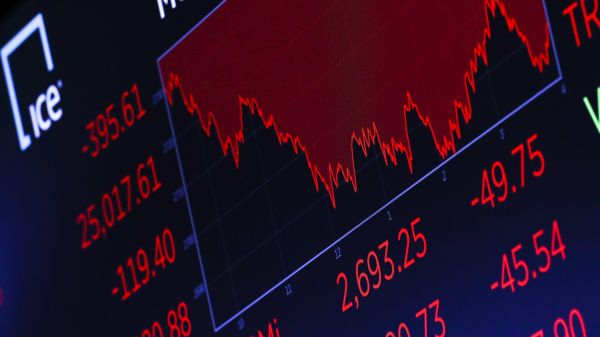The following resolution was passed at the International Executive Committee (IEC) of the Committee for a Workers International (CWI), the international socialist organisation to which the Socialist Party in Ireland is affiliated to. It gives an analysis of the potential for a new crisis for the world capitalist economy and the impact this will have on the consciousness of the global working class.
We are rapidly approaching a decisive turning point in world relations with a slowdown in the world economy increasingly pointing towards a deeper downturn, including the possibility of a 2008-9 type financial crash. Such a development would find capitalism far less prepared to respond than it was a decade ago. It could temporarily cut across working class struggle in some countries while leading to sharp crises and even pre-revolutionary situations in others.
In most countries the 2008 crisis found the working class largely unprepared. This is less true this time despite working class organization remaining weak overall and the lingering effects on consciousness of the collapse of Stalinism. This brief statement will outline how the economic crisis is unfolding and the likely effects it will have on working class consciousness.
The main immediate cause of the current downturn is likely to be the effect of the growing trade conflict on an already fragile world economy where there has been a massive pileup of debt. Global trade is decelerating rapidly. Yearly growth in world trade is down from 5.5% in 2017 to 2.1% this year according to the OECD. This can be compared to an average growth of world trade of 7% between 1987 and 2007. An important factor in this deceleration is the uncertainty created by Trump weaponizing the threat of tariffs as a key tool of his nationalist foreign policy. Trump’s conflict with China is already having serious effects with the latest data showing U.S. exports to China falling 31.4% from a year earlier while Chinese exports to the U.S. are down 7.8%.
It is also striking that Foreign Direct Investment (FDI) globally fell by 3% last year, to the lowest level since the financial crisis. The decline of FDI, a hallmark of globalization, is itself an indication of the partial reversal of globalization we have described, which the Economist has termed “slowbalization”.
In previous material, we have enumerated some of the indicators pointing to a downturn in the world economy and also how the developing trade conflicts, especially that between the U.S. and China, are directly contributing to accelarating this process. In April, the International Monetary Fund projected a slowdown in growth for 70% of the world economy in 2019. Many commentators are now talking about a global recession beginning before the end of this year. This is characterised as when global growth goes below 2.5% per year, the “stall speed” of the world economy. The World Bank in June revised its growth projection for 2019 downward from 2.9% to 2.6%.
Another key indicator is the Purchasing Manager Indexes (PMI) which measures manufacturing and service sector activity. Any PMI measure below 50 indicates contraction. Global manufacturing is already near 50 in the PMI but services which account for two thirds of global economic activity are also sliding back towards levels last seen during the mini recession in 2015-6.
How the Crisis Is Unfolding
To get a clearer picture it is worth looking at how this process is playing out in key regions and countries.
The Chinese economy slowed rapidly in 2018, its weakest recorded growth in 28 years. Industrial output is falling and there is rising unemployment including in the tech sector. According to the World Bank, GDP growth for 2019 is projected to be 6.2%, down from 6.6% in 2018, but the real level is probably 3-4% or even lower. International firms are pulling back from investment in China because of the uncertainty due to the trade war with the U.S. But manufacturing firms have also been shifting operations to Southeast Asia over the past period because of rising labor costs in China.
The U.S. economic recovery will soon be the longest ever recorded although the benefits of the recovery have gone overwhelmingly to the rich. So the U.S. is certainly “overdue” for a recession and there are indeed increasing signs of slowdown. The U.S. manufacturing PMI dropped to 50.6 in May, the lowest reading since August 2009. After headline growth of 3.1% in the first quarter of 2019 due to temporary factors, one model (the Atlanta Fed’s GDP Now) estimates second quarter growth to be 1.3%. In reality, there is weakness in many key areas of the economy including manufacturing, in the housing market and consumer spending.
Trump’s ability to weaponize trade – by threatening global supply chains – in one sense shows the clout that U.S. imperialism still has. The trade war with China has clearly created serious difficulties for Xi Jingping’s regime, along with the overall slowdown in the economy and developments in Hong Kong. The U.S. has also used the continued relative strength of the dollar as the global “reserve currency” to threaten firms and banks – for example those doing business with Iran – with exclusion from the dollar payment system. This is a potent threat given that, as the Economist points out, “Some 88% of currency trades use greenbacks”. We also see attempts to counter this dominance of the dollar with, for example, Russia increasingly trading in Euros or even Rubles and – on a much lower scale and also with a strong speculative element – the rise of crypto currencies and projects like the Facebook money Libra that can work around the restrictions of states.
But while the U.S. is able to inflict pain it is also meeting stronger resistance than previously from its competitors. For example, in response to the threat to European banks doing business with Iran, the EU devised a barter system for trade with Teheran. And clearly the trade wars will have an economic impact in the U.S. as well with lower profits for many firms dependent on Chinese imports, higher consumer costs and possibly significant job losses.
Reflecting the deteriorating position in the U.S. the Federal Reserve is indicating that it is likely to lower interest rates this year after slowly raising them for several years and initially resisting Trump’s demands to cut them. Trump had poured gasoline on an overheating economy with his 2017 tax cuts but their effects in boosting growth are now almost gone. It was claimed that the tax cuts would give businesses more money to invest in expanding operations, but unsurprisingly the bulk of it was used for stock buybacks.
Meanwhile, the Eurozone has narrowly avoided going into recession for the third time in a decade but it is clear that external shocks as well as internal could tip it over. The World Bank has lowered its Eurozone growth projection for 2019 from 1.4% to 1.2%. The Bank’s recent midyear report declared, “Economic conditions in the euro area have deteriorated rapidly since mid-2018, particularly in the manufacturing sector.” The manufacturing sector in the Eurozone as a whole contracted for the fourth consecutive month in May this year. Manufacturing PMI in May was at 47.7. Investments are low and bourgeois commentators point to the fact that the “old continent” is lagging behind in innovations and new technologies. A coming crisis threaten both the euro and the EU in its current form as national interests increasingly come into conflict and nationalist politicians point to the EU as a cause of the crisis.
Germany, the Eurozone’s largest industrial economy and biggest exporter, experienced a 1.9% contraction in industrial production in April. Perspectives of growth are down to under 1% for 2019. Orders for manufacturing products were down 2.2% in May on a monthly basis and down 8.6% on an annual basis. This drop was much greater than the expected 0.3% by economists who took part in a Wall Street Journal survey. The crucial auto sector has been particularly hard hit. Volkswagon’s sales in China went down 7% from January to May. A report by Germany’s Center for Automotive Research projects a drop in global auto sales in 2019 of four million. The author’s report, Ferdinand Dudenhoffer, points out that “Globally this is twice as big a decline as in the midst of the global financial crisis.” (Forbes, 6/12/19) His analysis does not include the effects of Brexit or possible U.S. tariffs on the European auto industry.
Draghi, the outgoing head of the ECB, is already discussing taking serious measures in the coming months. For example, the bank could increase the so-called negative interest rate on commercial banks’ deposits at the central bank. This is effectively “a penalty on the deposits and a way of nudging banks to put the money to work in the economy.” (New York Times, 6/19/19) The ECB is also preparing to expand Quantitative Easing again, effectively printing money on a very large scale, to stimulate the economy. This policy of cheap money is most likely to be continued by the next ECB head Christine Lagarde – and will increase the already large bulk of debts in Europe even further.
Although less discussed, Japan remains the world’s third largest national economy. Despite aggressive stimulus measures, including running massive government deficits (the ratio of debt to GDP is the highest in the world), the economy is “worsening” according to the government for the first time in six years. In fact with the World Bank projecting growth at 0.8%, the position is even weaker than in the EU.
Even Australia, with a record 28 year economic expansion, is now facing the real possibility of recession.
The picture in the “developing” economies is even more serious. The latest figures indicate that Russia has been in recession for two quarters. Real incomes have been declining for six years. Turkey, Argentina and Pakistan are already in recession while Brazil and South Africa are both on the brink. In the case of Brazil, this comes in the wake of a short-lived recovery after the most devastating recession in the country’s history. India is the exception with the World Bank projecting an acceleration of growth to 7.5% during 2019/20.
The situation in Turkey is an example of how a very sharp crisis can develop rapidly. Debt-fuelled growth has hit the wall as international investors started pulling out. This led to the rapid devaluation of the lira, down more than 40% against the dollar since the beginning of 2018. Inflation is now at 19% with real wages dropping rapidly while unemployment is at 14%. The Turkish government and private companies have accumulated $328 billion worth of medium and long term debt, most of it in dollars. With the lira rapidly depreciating, the situation could become very unstable and even explosive. Moody’s has already downgraded a number of key Turkish banks. The political effects of the crisis, shown by the huge defeat for Erdogan and the AKP in the Istanbul mayor election, will continue.
This data from both the ACCs and developing economies paints a clear picture of a simultaneous slowdown across much of the world economy, with some countries already entering a sharp crisis.
The Causes of the Downturn
We need to distinguish between the immediate triggers of the coming recession and the longer term causes of capitalism’s structural crisis. The immediate cause of the Great Recession of 2008-9 was the bursting of the bubble in the derivatives market due to the “sub prime” loans pushed by the big banks in the U.S. housing market. This led to the collapse of other asset bubbles.
The main immediate cause of the current downturn as we already said is very likely to be the effect of the slowing of world trade and growing trade conflict which did not begin with Trump but has accelerated under him.
The deeper structural problems facing the capitalist economy go back to the end of the post-war boom in the 70s. The key contradition in capitalist economy in this era can be characterized as an overaccumulation of capital, a growing tendency for more surplus value to be produced than can find be profitably invested. This crisis of profitability led to a search for for new fields for investment particularly through privatization of big sections of the public sector in many countries, including pension systems, healthcare and education. The crisis of profitability also led to a growing “financialization” of the system beginning in the 80s, including an ever greater role for the banks and a massive expansion of credit. This in turn led to the phenomenon of debt-fuelled growth with global debt now three times the level of global GDP.
And of course financialization has also meant an ever-growing global casino. There was much commentary 10 years ago about the role of “bubbles” full of fictitious capital in the financial markets whose implosion had a devastating effect on the real economy. But capitalism has shown no ability to change its behavior. Literally the solution to the financial crisis of ’08-’09 was to “start blowing new bubbles”. The global financial casino is now even bigger than in 2009. $1.2 quadrillion are invested in the derivatives markets while currency speculation accounts for $5.3 trillion every single day!
Capital is always looking for new fields to invest. Currently one of these is the technology sector, which seems to be an exception to the overall failure of the capitalists in the past period to develop the forces of production. But the flow of capital into technology is not only an attempt to win the international race of competition but has, in an environment where so much capital is searching for profitable outlets, also a speculative character. This can lead to bubbles. The tech sector will also be adversely affected by the trade conflict with China. Other bubbles are developing in many countries with finance capital investing in housing (plus the disastrous social effects). But in a period of shrinking profitability various fields can become new fields for investment and even bubbles like crypto currencies and also “Green economy”.
Perspectives
We can’t say beforehand how deep the coming downturn will be and whether it will be comparable in scale to the ’08-’09 crisis. If a partial agreement on trade were reached between Trump and Xi Jinping this could give a very temporary boost to the world economy but it would not change the overall direction. However the Economist explicitly and correctly warns that “the risk of a clumsy mistake [in the trade conflict] that triggers a financial crisis is high.” This is a reference to talk of the U.S. cracking down on Chinese companies worth $1 trillion trading in U.S. financial markets or other threatened retaliatory measures by both sides.
Several factors point to the danger of an even more serious crisis than a decade ago. As we have pointed out, capitalism’s “toolkit” is depleted which is not to say it is empty. The drastic measures used to respond to the 2008-9 crisis included Quantitative Easing and negative interest rates that helped save the system from an even deeper crisis but created new contradictions. Nevertheless there seems to be little or no prospect of the type of coordinated response that Obama organized with the EU and China to prevent an even deeper global slump. A key part of this response was the massive stimulus program in China which led to enormous demand for raw materials from around the world. The stimulus program in turn created a debt bomb in China which now impedes a further stimulus program on this scale.
This also points to a broader point: after the ’08-’09 crash the BRIC (Brazil, Russia, India and China) economies, particularly China, acted as an engine that pulled the capitalist economy out of the hole. This will certainly not happen this time.
Again it should be stressed it is not possible to say conclusively how deep the coming downturn will be but the overall situation points to a very deep crisis and not a “mini-recession” as in 2015-16.
Effects on Consciousness
The enormous impact on consciousness of the ’08-’09 crisis of course continues to this day, with vicious austerity policies still in place in many advanced capitalist countries. In most countries the “recovery” of the last years has not led to an increase in living standards and new jobs are often precarious. Working people and young people who have lost faith in the system and its institutions will not be surprised by the new phase of capitalism’s crisis.
It is certainly the case that in many countries there can be a partial “stunning effect” on the class struggle. For example, if the U.S. economy goes into recession in the next year, it would likely cut across the strike wave in the U.S. that has centered on the teachers’ revolt. But in the U.S. we also see the mass support for the radical reforms proposed by “democratic socialists” like Ocasio Cortez and Bernie Sanders. This was a factor that did not exist in 2008-9 and is the result of the radicalization of millions of workers and youth since Occupy. This factor points clearly to the stunning effect being of shorter duration more limited than during the Great Recession and mass anger at the system being more quickly turned into mass struggle including further steps towards the rebuilding of a fighting labor movement. While a general rise in industrial struggle could be cut across for a period, struggle could be channeled onto the political plane in terms of elections, political organization, and mass struggle on political and social questions. Sooner or later there would be a resumption of further steps towards the rebuilding of a fighting labour movement and a growth in industrial action.
In this situation, much bolder demands, including for public ownership of key sectors of the economy, can begin to gain a much wider echo. This is already evident in the discussion around the Green New Deal in the U.S. Despite the limitations of the proposal, we are able to point to the bold goal of transitioning the economy to renewable energy to get a hearing for bringing the entire energy sector into public ownership. As the climate crisis worsens, bolder socialist demands could gain mass support in many countries. A different example is in Berlin where the desperate housing crisis has provoked a movement for a referendum to expropriate corporate landlords who now own a large part of the city’s housing stock. This struggle could have international implications.
It is also very striking that the economic crisis in Turkey and in Brazil is already playing an important role in undermining the position of authoritarian and right populist figures who find themselves in power when the storm hits. In Turkey, the rapidly worsening economic conditions described above played a direct role in handing Erdogan and the AKP party their biggest political defeat in 16 years in power, In the rerun of the Istanbul mayoral election, at the end of June, Erdogan suffered a much more more serious loss than in the first round at the end of March.
In Brazil, Bolsonaro’s poll numbers have slumped drastically and the recent general strike against his neo-liberal pension reform has put him firmly on the defensive. We should not forget how the deep economic crisis in Argentina at the beginning of this century brought that country rapidly towards a pre-revolutionary situation. This could certainly happen in a number of countries in the next period due to catastrophic economic crises.
If the recession hits in the U.S. in the next year, it could have a significant effect on the presidential election. If those sections of the working class who supported Trump begin to conclude that he has not delivered on his promise to bring back good jobs to hard hit industrial areas this could doom Trump’s chances of re-election. There are indications of this beginning in some key Midwestern states.
But these trends should not blind us to the dangers in the situation. All of the weaknesses of the “new left” will be on full display in the coming crisis. If the left and the labor movement fail again to give a real lead to working people who want to fight back against the bosses and the corrupt political class, the way will be opened even more to the right populists and the far right. As is evident with the trade war, increasingly nationalist and protectionist policies will deepen the downturn. An important feature of this crisis which is different to 2008-9 is the way in which right-wing populism and the downturn can feed on each other. The dangerous growth of anti-immigrant sentiment in many countries, encouraged and whipped up by governments and establishment parties, in the past period is a warning of what can develop in the next period, if the left and the working class does not lead a struggle for a socialist alternative.
A different example of the effect of the coming downturn can be to reignite the Eurozone’s if the left and the working class offers no answers and solutions to questions related to the economic crises and migration. Already the situation in Italy is very serious with the government considering taking steps towards a parallel currency to the Euro. The part of the Italian ruling class that advocates or wants to prepare a break from the Euro fears the extreme cost of debts denominated in Euros, similar to the crisis in “emerging” countries with huge debts in foreign currency. Meanwhile the Brexit crisis rumbles on. The German and French ruling class were barely able to maintain the Eurozone after 2008. They had to resort to all sorts of extreme measures. This balancing act may not be sustainable with another sharp downturn. The breakup of the Eurozone with a number of countries leaving and the Euro being reduced to a core set of countries is a possibility that we must have in mind in the next phase. Such a development would almost inevitably be accompanied by explosive political and social struggle, with radical left conclusions being drawn by large sections of the population, particularly the youth, but with the far right and nationalist forces also being strengthened.
While it is argued by Keynesian economists that governments can expand their indebtedness as long is it is denominated in their own currency, the situation in the Eurozone points to the limit of that argument. A different debt crisis is already opening up with countries in China’s Belt and Road program facing onerous debt repayments to China for infrastructure investment. This could be an important factor in the next period.
A new global economic crisis combined with escalating climate catastrophe opens up the prospect of an even more explosive period than the last. In the period after the Great Recession of 2008-9, the working class was not able to put its imprint decisively on events, by pushing back the assault of the ruling class and go on the counteroffensive. The central reason for this is the role played by the leadership of the unions and the left parties and formations, old and new. Despite this, however, the consciousness of large layers did advance. Millions were radicalized and sought an alternative to system in the direction of left and socialist ideas.This mood of struggle and defiance was also reflected in the rise of the powerful social movements against oppression especially by women in many countries and by young people in defense of the environment in the past years. It was also directed to movements to defend education or pensions against neo-liberal attacks or against national oppression, as in Catalonia. We can expect similar processes to continue and deepen.
Irrespective of what form and what intensity class and social struggles take, something that cannot be predicted in advance, the consciousness of millions will undoubtedly develop in an anticapitalist and socialist direction. This will provide the fertile ground on which the forces for the socialist revolution should intervene and built. The main obstacle in this direction will again be the leadership of the unions and the parties of the “left”, and particularly the New Left Formations. Their failure to lead creates the space for right wing populism and the far right which will be a complicating factor though it cannot halt the process of left radicalization in big sections of the working class, particularly among young people. This radicalization can lead to new political initiatives and to challenges to the existing union leaders, including in some cases the formation of new unions and new left, socialist, working class organisations and parties.. It is therefore of critical importance that every opportunity is used to intervene in the process of radicalisation to win the best activists to develop them into cadres to ensure that a clear revolutionary alternative is posed as the process unfolds.
Of course there is no “final crisis” for capitalism. Even a complete economic collapse would eventually create the conditions for capital accumulation to resume. The capitalists may be forced by the scale of the crisis and the threat of social upheaval to take more drastic measures. This can include taking steps towards increased state intervention with a more aggressive national or regional “industrial policy” of state investment in key sectors. This would represent a more decisive break with globalized neo-liberalism and could strengthen reformist illusions in sections of the working class for a period. But this will not end the anarchy of world capitalism and its inability to offer a way out of the crisis facing humanity.
The CWI, parties, members and supporters will be part of the coming struggles, initiate them where possible and fight within the movements, trade unions and parties for a socialist program that links the necessary way forward to win the respective struggles with the necessary strategy to abolish the roots of the problems – capitalism. It needs a worldwide revolutionary process as the only way out and the global working class, objectively stronger than it has ever been, is the only force that can lead it to win a world free of exploitation and oppression, based on needs and starting the real history of mankind.












